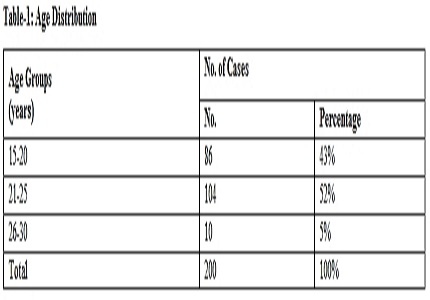Study of glycolic acid and salicylic acid peels as a sole therapy in treatment of acne vulgaris
Abstract
Introduction: Acne vulgaris is a very common physiological condition of adolescents, better regarded as a disease due to some inflammatory component. In spite of various modalities of treatment available, it still poses a therapeutic problem to the dermatologists. The advent of new and potent topical therapeutic modalities such as chemical peeling has resulted in significant improvement in the treatment of acne. This study aims to observe the therapeutic response of two chemical peels, 35% glycolic acid and 30% salicylic acid on active acne lesions, when given as monotherapy.
Materials & Methods: A total of 200 patients of either sex with acne were randomly selected and enrolled for the study, two groups of 100 patients each were made of 35% GA and 30% SA respectively. No other concurrent therapy was given. Individual lesions of each type were calculated before and after completing 6 treatment sessions and the numbers were observed to know the effect of both the acids on different types of lesions.
Results: After 6 sessions, in the glycolic acid group the reduction in average number of comedones was 88.45%, inflammatory papules 88.65%, pustules 89.62% & nodules/cysts 83.33%. Whereas, in the Salicylic acid group, the reduction was 89.00%, 90.36%, was 84.87% & 100% in comedones, papules, pustules & nodules/cysts respectively.
Conclusion: In our observation, both 35% glycolic acid and 30% salicylic acid are significantly effective as monotherapy in patients of acne. They not only clear the acne lesions but also show improvement in post acne scar and hyperpigmentation to some extent.
Downloads
References
Saraf V: Chemical Rejuvination of the face of non facial areas in Asian skin.1st edition 2003, Page no 5( https://books.google.co.in/books).
Conellessa C,Peris K, Onorati M T, Fangnoli MC, Chemiti, The use of chemical peeling in the treatment of different cutaneous hyperpigmentation, Dermatol surg. 1999 June 25 (6) 50-4.
Edward Kessler, BA, Katherine Flanagan, Christina Chia, Cynthia Rogers, and Dee Anna Glaser : Comparison of a- and b-Hydroxy Acid chemical peels in the treatment of mild to moderately severe facial acne vulgaris, dermatol surg. 2008;34:45-51.doi: https://doi.org/10.1111/j.1524-4725.2007.34007.x.
Grover C, Reddu BS, The therapeutic value of glycolic acid peels in dermatology, IJDVL, 2003; 69;2;148-150.doi: http://www.ijdvl.com/text.asp?2003/69/2/148/5903.
Bernstein EF, Lee J, Brown DB. Glycolic acid treatment increases type 1 collagen mRNA and Hyaluronic acid content of human skin. Dermatol Surg2001;27:429-33.doi: https://doi.org/10.1046/j.1524-4725.2001.00234.x.
Lazo ND, Meine JG, Downing DT. Lipids are covalently attached to right corneocyte protein envelopes existing predominantly as B-sheet: a solid- state nuclear magnetic resonance study. J Invest Dermatol 1995;105(2):296-300.doi: https://doi.org/10.1111/1523-1747.ep12318985.
Swinehart JM. Salicylic acid ointment peeling of the hands and forearms: effective nonsurgical removal of pigmented lesions and actinic damage. J DermatolSurg and Oncol1992;18(6):495-8.doi: https://doi.org/10.1111/j.1524-4725.1992.tb03311.x.
Imayama S, Ueda S, Isoda M. Histologic changes in the skin of hairless mice following peeling with salicylic acid. Archives of Dermatology 2000;136(11):1390-95.doi: https://doi.org/10.1001/archderm.136.11.1390.
Atzori L(1), Brundu MA, Orru A, Biggio P. Glycolic acid peeling in the treatment of acne. J Eur Acad Dermatol Venereol. 1999 Mar;12(2):119-22.
Grover C, Reddu BS, The therapeutic value of glycolic acid peels in dermatology, IJDVL, 2003;69;2;148-150.
Garg VK, Sinha S, Sarkar R, Glycolic acid peels versus salicylic-mandelic acid peels in active acne vulgaris and post-acne scarring and hyperpigmentation: a comparative study. Dermatol Surg. 2009 Jan;35(1):59-65. doi: https://doi.org/10.1111/j.1524-4725.2008.34383.x. Epub 2008 Dec 8.
Pearl E. Grimes, MD, The Safety and Efficacy of Salicylic AcidChemical Peels in Darker Racial- Ethnic Groups. Dermatol Surg.1999; 25:18-22.doi: https://doi.org/10.1046/j.1524-4725.1999.08145.x.



 OAI - Open Archives Initiative
OAI - Open Archives Initiative


